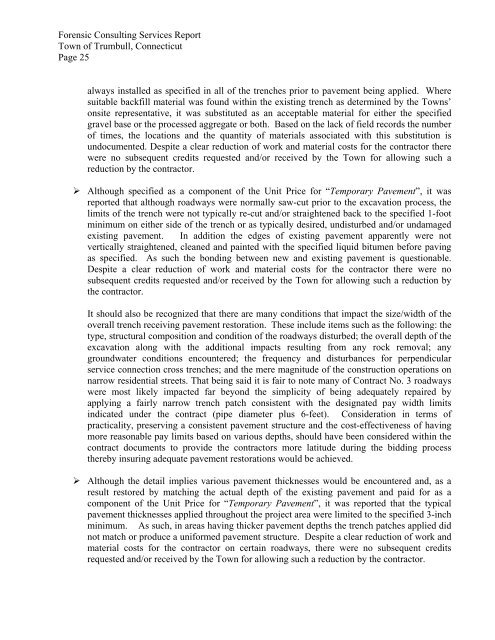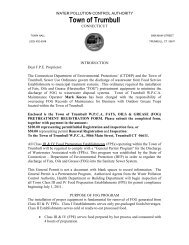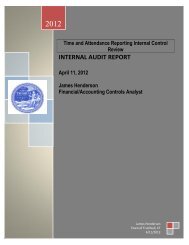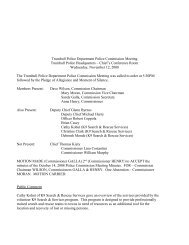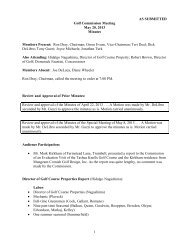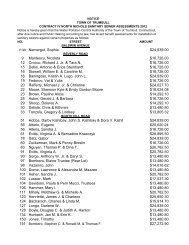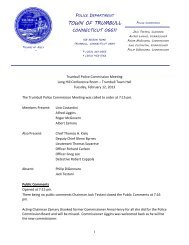Forensic Audit Report-WPCA Phase IV, Part B. Contract ... - Trumbull
Forensic Audit Report-WPCA Phase IV, Part B. Contract ... - Trumbull
Forensic Audit Report-WPCA Phase IV, Part B. Contract ... - Trumbull
Create successful ePaper yourself
Turn your PDF publications into a flip-book with our unique Google optimized e-Paper software.
<strong>Forensic</strong> Consulting Services <strong>Report</strong><br />
Town of <strong>Trumbull</strong>, Connecticut<br />
Page 25<br />
always installed as specified in all of the trenches prior to pavement being applied. Where<br />
suitable backfill material was found within the existing trench as determined by the Towns’<br />
onsite representative, it was substituted as an acceptable material for either the specified<br />
gravel base or the processed aggregate or both. Based on the lack of field records the number<br />
of times, the locations and the quantity of materials associated with this substitution is<br />
undocumented. Despite a clear reduction of work and material costs for the contractor there<br />
were no subsequent credits requested and/or received by the Town for allowing such a<br />
reduction by the contractor.<br />
‣ Although specified as a component of the Unit Price for “Temporary Pavement”, it was<br />
reported that although roadways were normally saw-cut prior to the excavation process, the<br />
limits of the trench were not typically re-cut and/or straightened back to the specified 1-foot<br />
minimum on either side of the trench or as typically desired, undisturbed and/or undamaged<br />
existing pavement. In addition the edges of existing pavement apparently were not<br />
vertically straightened, cleaned and painted with the specified liquid bitumen before paving<br />
as specified. As such the bonding between new and existing pavement is questionable.<br />
Despite a clear reduction of work and material costs for the contractor there were no<br />
subsequent credits requested and/or received by the Town for allowing such a reduction by<br />
the contractor.<br />
It should also be recognized that there are many conditions that impact the size/width of the<br />
overall trench receiving pavement restoration. These include items such as the following: the<br />
type, structural composition and condition of the roadways disturbed; the overall depth of the<br />
excavation along with the additional impacts resulting from any rock removal; any<br />
groundwater conditions encountered; the frequency and disturbances for perpendicular<br />
service connection cross trenches; and the mere magnitude of the construction operations on<br />
narrow residential streets. That being said it is fair to note many of <strong>Contract</strong> No. 3 roadways<br />
were most likely impacted far beyond the simplicity of being adequately repaired by<br />
applying a fairly narrow trench patch consistent with the designated pay width limits<br />
indicated under the contract (pipe diameter plus 6-feet). Consideration in terms of<br />
practicality, preserving a consistent pavement structure and the cost-effectiveness of having<br />
more reasonable pay limits based on various depths, should have been considered within the<br />
contract documents to provide the contractors more latitude during the bidding process<br />
thereby insuring adequate pavement restorations would be achieved.<br />
‣ Although the detail implies various pavement thicknesses would be encountered and, as a<br />
result restored by matching the actual depth of the existing pavement and paid for as a<br />
component of the Unit Price for “Temporary Pavement”, it was reported that the typical<br />
pavement thicknesses applied throughout the project area were limited to the specified 3-inch<br />
minimum. As such, in areas having thicker pavement depths the trench patches applied did<br />
not match or produce a uniformed pavement structure. Despite a clear reduction of work and<br />
material costs for the contractor on certain roadways, there were no subsequent credits<br />
requested and/or received by the Town for allowing such a reduction by the contractor.


